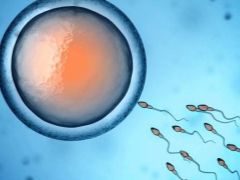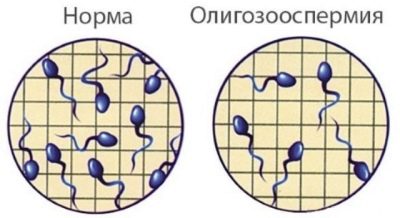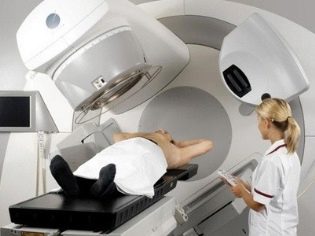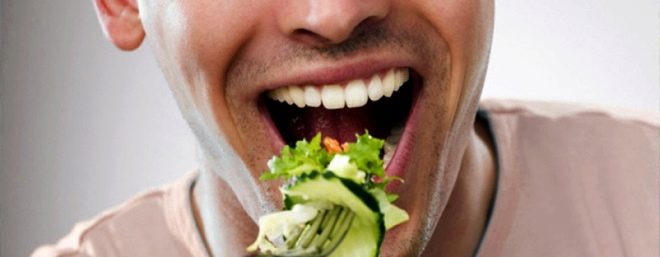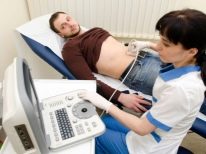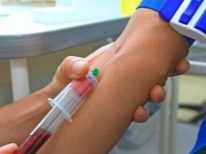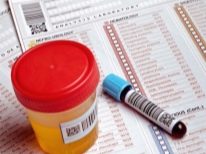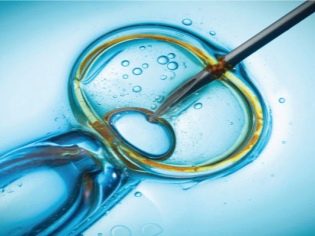What is oligospermia and how does it affect conception?
In today's world, filled with stress and adverse factors, it has become increasingly difficult for men to maintain their reproductive health. Among the many forms of male infertility, oligospermia has very often become common lately. We will tell in more detail about what this pathologists are, if there is any chance of conceiving a child with her.
What it is?
Male fertility is directly influenced not only by the qualitative composition of seminal fluid, but also by its quantity. Normally, a healthy, normal male produces about 3-5 ml of semen per ejaculation. This number is considered quite sufficient for conception to occur without problems. If the amount of ejaculate is reduced and is less than 3 ml, then they say that this man has oligospermia.
The number of active, live and fertilizable spermatozoa can theoretically be preserved in a small amount of sperm, but oligospermia is rarely an independent form of infertility. Usually it is combined with erectile dysfunction, the inability to release sperm during orgasm. Oligospermia is often combined with asthenozoospermia, in which the motility of male germ cells is impaired.
About oligospermia, or rather, about its variety, they say in the case, if the concentration of living and mobile, healthy sperm in the ejaculate is below normal. The World Health Organization recommends comparing the value of the results of spermogram with a standard of 20 million cells per ml. If the man contains less sperm, then diagnose "oligozoospermia."
Doctors suspect that this problem is characteristic of at least half of modern men, but it is not possible to calculate more precisely, because the oligospermia becomes known only when the couple turns to doctors to help find the cause of infertility. Men who do not go to the doctor and do not make a spermogram may not know all their life that the illness has not bypassed them.
But there is a very definite statistics regarding the cases of male infertility. Among all those who make spermogram about the inability to conceive a child, oligospermia is detected in about 20% of cases.
Causes
The reasons for reducing the number of motile and healthy sperm in the ejaculate and the number of ejaculate itself may be different. We present only some of the most common ones.
- Varicocele. Varicose veins of the scrotum is dangerous because the temperature in the scrotum increases significantly. That is why oligospermia is often observed with varicocele.
- Infections. The violation of the number of spermatozoids suitable for conception can be caused by venereal diseases, as well as infections that are commonly referred to as hidden, for example, chlamydia. Also, the reason for the decrease in reproductive abilities can be any infection of the genitourinary system, if it is not treated for a long time. Chronic infectious diseases often lead to oligospermia.
- Genetic causes. Sometimes oligozoospermia is a genetic feature of a man (it can be inherited from his father, for example).In this case, all tests are normal, no abnormalities, the body is healthy except for the composition of seminal fluid. Sperm cells can initially be produced in small quantities.
- Retrograde ejaculation. Many men with the process of ejaculation problems do not arise. But often oligospermia is recorded in men with retrograde ejaculation, in which sperm is thrown in the opposite direction, that is, in the bladder.
- Injuries. Any injuries and bruises of the scrotum and penis, as well as tumors can cause disturbance of the outflow of seminal fluid and reduce its reproductive value.
- Medicines The number of sperm cells suitable for conception is significantly reduced in men who have taken antibiotics for a long time, as well as blood pressure reducing agents.
- Hormones. The cause of oligospermia can be disorders of the thyroid gland, pituitary disorders, as well as the unauthorized administration of hormonal drugs. So, often men-sportsmen take anabolic steroids in order to quickly bring their body shape to the desired. Quite often, this is what causes the development of male infertility in the form of oligospermia.
- Toxic effects. The reason for reducing the number of sperm and ejaculate volume can be in the harmful effects on the male body of heavy metal salts, pesticides, painting materials. This most often happens with men who are employed in "harmful" enterprises and construction sites.
- Irradiation. Men who received radiation treatment for cancer, for the most part suffer from oligospermia. Also, from exposure to ionizing radiation, pathology develops in those who have contact with radioactive materials and installations.
- Unhealthy Lifestyle. Systematic use of alcohol, tobacco, drugs can not affect the number of live sperm. The longer a man abuses, the less germinal cells are found in his seminal fluid.
Often, men themselves do not realize that they are doing great harm to themselves, the consequences of which may then prevent them from continuing the race. This applies to the passion for visiting the bath and sauna, to the use of electric heating of the seats in the car - overheating of the scrotum and testicles is dangerous for men's health. Also, the number of spermatozoa is often found in men who lead a very nervous lifestyle and are often under severe stress, in overweight men, leading a hypodynamic lifestyle.
Often, oligospermia are diagnosed in men who are malnourished, for example, in vegetarians, because a small amount of protein food does not contribute to the intensive processes of development in the male body of young and healthy spermatozoa. Also, this disease can be found in the stronger sex, who prefer to wear slimming swimming trunks and tight pants.
Degree of ailment
A total of four degrees of oligospermia are known. At the first degree, the content of spermatozoa in the total volume of the ejaculate is in the range of 40-60 million. Grade 2 oligozoospermia is the content in the ejaculate from 20 to 40 million cells. In the third degree, the concentration of germ cells ranges from 5 to 20 million, and the most complex fourth degree implies the presence of less than 5 million sperm cells.
Diagnostics
To begin with, the doctor will need to establish whether oligospermia is not physiological. This can happen if the man is too active sex life: the amount of sperm in this case decreases, but without compromising its quality. It is usually recommended to refrain from intimate relationships for about 5-6 days and retake the spermogram.
If the diagnosis is confirmed, the man is prescribed additional examinations. Rejecting them in any case is not necessary, because they will help to establish the true cause of the problem and find a way to solve it. Usually this may require:
- general urine and blood tests;
- tests for sexually transmitted infections and genital infections;
- HIV test;
- Ultrasound of the pelvic organs;
- conclusion of the urologist;
- blood test for hormones.
The rest of the tests and examinations are prescribed by the doctor on an individual basis.
Impact on conception
The inability to independently conceive a child with oligospermia is quite understandable: on the way to the egg, most male germ cells die, and if the number is already insufficient, then it is difficult to expect that at least one “daredevil” will reach the cherished goal.
Despite the prevalence of this disease, oligospermia is considered the simplest form of male infertility, in which, even without appropriate treatment, there are chances to conceive a child on their own, although they are very small. In assessing the fertility of a man, it is important to necessarily evaluate the degree of hypospermia (this is another name for oligospermia). The probability of pregnancy is proportional to the severity of the disease.
But even the 4th degree of the disease is not a sentence, and a man may well become a dad, provided that he agrees patiently and gradually to be treated. Treatment may take from several months to a year.
Treatment
The treatment is aimed primarily at eliminating the cause, which caused a violation of the quantity and quality of seminal fluid in a man. If it is an inflammatory process, antibiotics are prescribed, and in case of a viral ailment, antiviral treatment is given and special attention is paid to strengthening the immune system. Varicocele needs surgery, after which the reproductive functions are restored in full.
It is customary to treat oligospermia in a complex way - there is no any universal drugs, which can save a man from the problem. It is usually recommended to change lifestyle: say goodbye to bad habits, start eating right, take vitamins A, C and E, folic acid, as well as drugs that belong to dietary supplements: "Spermaktin", "Verona", "Viardot", "Seltsink" .
A man should refrain from excessive physical exertion, but at the same time not lead a couch lifestyle. Light runs, walks in the fresh air will only benefit. Men with oligospermia are recommended a special sexual regime: the frequency of sexual contact should not be too frequent, but prolonged abstinence is also not recommended. Doctors consider the optimal frequency 2-3 times a week.
After starting treatment for 3-4 months, you need to retake the spermogram to assess the dynamics. If the situation has improved, doctors prescribe concurrent treatment for the woman. She is recommended to take vitamins and the use of vaginal means, which should put in order the microflora, eliminate excessive acidity, so that as many male germ cells as possible can get to the target alive.
If the treatment did not help
If the treatment did not help, it most likely means that the cause of the problem lies in the genetic characteristics of the man. It is useless to treat, but he has chances for fatherhood. If there are no other pathologies according to the results of spermograms, live and active sperm cells can be isolated under laboratory conditions using modern super-power microscopes. A woman in this case can become pregnant with several methods.
Most often, it is recommended to do this through intrauterine insemination, in which sperm is injected into the cervix, thereby the path of the male sex cells will be shorter, and the chances of conception will increase.
If there are concomitant deviations, the methods of IVF, ICSI, ICSI-MAX can be applied. According to the testimony, if male infertility is not treated, assisted reproductive technologies are carried out under the policy of compulsory health insurance.
Reviews
According to the reviews of women, their husbands, for the most part, are hard on the diagnosis, especially if the doctors immediately establish 3-4 degrees of oligozoospermia. Many representatives of the stronger sex begin to worry, refuse to discuss future prospects with his wife. Women who have successfully passed this way along with their second half, argue that you just need to give a man time, do not rush him. The day will come when he can calmly discuss the treatment, undergo additional research and begin treatment.
A diagnosis like hypospermia is always a test of family strength. If the spouses do not divorce, do not give up, the treatment in the majority gives the desired results. Some women report that they are waiting for the second baby after the husband once underwent a long course of treatment. On average, the treatment takes about six months.
About male infertility and how to help a man become a father, see the following video.
